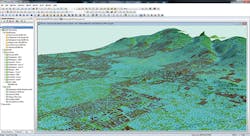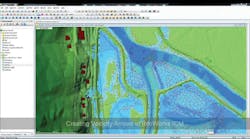The focus for stormwater managers these days is resilience, says Sam Hinojosa, P.E., CFM, director of water resources in the north Houston, TX-area for Halff, a multi-discipline civil engineering firm. “We want to be resilient in our communities and to be resilient means more than coming up with a storm drain solution of ‘if water gets this deep, now it’s only going to get this deep. It’s going to be this much water and we can control this much of it.’”
“That’s basically how we’ve done things for a long time,” says Hinojosa. “We’re trying to address issues of resilience. How can a community bounce back? How long will these communities have water standing in their neighborhoods? If we implement this solution, how quickly can we get the water down? How quickly can we get people back to their homes?”
To that end, today’s stormwater modeling software helps achieve those goals.
With models offered by software such as InfoWorks ICM, end-users are able to go beyond sizing a pipe or an inlet and get a sense for how long water will be standing, how many people the event will impact and for how long, notes Hinojosa.
“What are some areas where roads will need to be closed down for a period of time because of high water and maybe we can prioritize which one of those areas we need to look at first to address some of those ponding issues,” he says.
“Those are some things resilience can do—how does it get the community back to what it was before or even better? With the power that these models have, we can do things which we couldn’t do before in a short amount of time.”
InfoWorks ICM (Integrated Catchment Modeling) is a hydrodynamic one-dimensional (1D)/two-dimensional (2D) integrated catchment modeling solution for rivers and sewer systems that offers real-time flood forecasting and risk management.
It is designed to study catchment areas with all elements of the drainage infrastructure and natural river systems and the interactions between them in a qualitative and quantitative level as a single workflow.
The software can be used for complete 2D modeling of surface water flows, including comprehensive water quality simulations and the designing and planning of sustainable urban drainage systems.
InfoWorks ICM is designed to provide a range of theoretical and empirical computational models for detailed simulation of runoff volume formation and routing over complex catchments while accounting for various hydrological processes including interaction with groundwaters, snowmelt, evaporation, and formation and transport dynamics of surface contaminants.
Its 1D/2D computational engine for simulating unpressurized flows in prismatic and non-prismatic channels is designed to serve as a universal platform for building from simplified design models to complex real-time operational models covering an entire water cycle over a given catchment.
Halff uses InfoWorks ICM quite a bit for stormwater modeling, notes Hinojosa.
Halff teams utilize it to monitor the weather, including a number of rainfall events that affected the Houston area earlier this year, assisting several municipalities in analyzing some of the rainfall data and creating preliminary ponding maps from that data so decision-makers could assess what happened and the resulting impact.
One city for which Hinojosa and his team have used InfoWorks ICM is Sugar Land, TX.
“They decided to go solely with InfoWorks ICM because of its ability to model stormwater both one-dimensionally and two-dimensionally,” he says. “It’s been a big help to the city.”
In early May, Sugar Land received a significant amount of water through a number of rainfall events, including one in which the city experienced 10 inches of rainfall that fell within 12 hours.
“They were able to look at some of their ponding maps that they put together using ICM models to see where the ponding was going to be and [what] potential issues people might have faced with the flooding,” says Hinojosa.
“It’s been very useful software for this. We’ve been using it to model neighborhoods and storm drainage systems. Using these models, we’ve been able to take a concept, design that concept, and build that design, which has been helpful for the city.”
Hinojosa has been using InfoWorks for 10 years. “At that time, it didn’t have a stormwater component, but was primarily a wastewater system model, so we were helping the developer at the time beta-test some of the software as they were trying to adapt it to a storm drain model.”
Over time, the software evolved into InfoWorks ICM, the integrated catchment model.
Hinojosa says there was a learning curve when he first started using it, but over time, it has become his preferred software solution.
Previously, his team had been using EPA SWMM quite a bit and some XPSWMM.
“With the GIS integration it has and the ability to map results—all of which we could not do with EPA SWMM—and it was a very nice change,” says Hinojosa.
“We can take an actual rainfall event, put it into our model rather quickly, simulate that event and identify the ponding and the flooding that happened as a result of that event,” he points out.
As a result, Hinojosa finds it helpful in creating ponding maps and visualizations.
“We can go back and replay an event. You can see the water ponding in the street, the direction of flow and then how the water receded afterwards,” he says. “That has been very helpful for presentation to clients, city councils and community residents. Those visual graphics go a long way. We can talk about numbers, flows, and depths all day long, but when you actually show people a video, then it makes all of the difference.”
Reactions from community residents to seeing the video has been along the lines of “that’s exactly what happened,” notes Hinojosa.
“Then you know you’ve done a good thing because the people who live out in these neighborhoods are the ones who see and know what happens,” he says. “The engineers are only collecting information and trying to understand what’s happening. But they saw it happen, and when you can re-create that in a model and confirm it, that validates what you are doing and you can create a better solution to try to address other situations.”
In one Sugar Land neighborhood, there had been a lot of road ponding. When it rained, it would get two inches in just a few hours, with the water standing in the street for up to seven hours, notes Hinojosa, adding that while the houses weren’t flooding, the roads would become impassable.
Sugar Land officials had done several studies, but it wasn’t until Hinojosa got involved, using InfoWorks ICM, that the city was able to have a master plan of improvement following his ability to use the software to model close to 50,000 linear feet of storm sewer.
The master plan was split up into five different projects.
“We did the design on the first project and had to adjust our modeling based off of survey data,” says Hinojosa. “Some adjustments had to be made during the design to make sure everything fit in the right of ways we were working in.”
The project initially entailed putting an open channel through a golf course.
“We used InfoWorks to develop graphics and visualizations for the neighborhood. Some of the residents saw what we were planning to do in a public meeting. They were not in favor of an open channel concept, so we went back with the city and re-evaluated other options,” says Hinojosa.
Using the model, Hinojosa and his team came up with a different solution—a combined swale with a storm sewer underneath it for the golf course. They were able to show visualizations with the InfoWorks ICM model to the city council, which approved the project and enabled him to move forward with completing the design.
“The project was constructed and substantially completed right before Hurricane Harvey hit Sugar Land,” says Hinojosa. “That area would pond with two or three inches of rainfall. Hurricane Harvey dropped more than 20 inches of rainfall and [the new] system worked perfectly.”
Sugar Land officials have noted how InfoWorks ICM can assist them in decision-making when it comes to emergency management and prioritizing projects, says Hinojosa.
“They’ve been a leader in the region going in that direction,” he adds. “Public safety is important. As engineers, we’re called to do help protect the public, so we want to do the best we can and use the best software that’s available,” he adds.
Sizing up the Solution
In stormwater modeling, “There are many ways to try to determine the size of the facilities that you need, but most of the ways that people use aren’t taking into account the complexity of what’s out there in the real world,” says Doug Beyerlein, owner of Clear Creek Solutions.
“They either come up with solutions that cost way too much money and are not feasible or they undersize the system such that even though they produce a solution, it doesn’t necessarily work in all situations. We’re looking in that sweet spot where we get the best solution for the least amount of money.”
The city of Bothell, WA, was experiencing flooding in a particular intersection and sought help from Clear Creek Solutions to do a hydrologic analysis in 2018 to determine the source of the flooding and how to mitigate it.
“Because it flooded, it affected a storm drain system which in theory should have been separate, but because it kept flooding, that storm drain system had to pick up that flood,” says Steven Morikawa, Bothell’s capital division manager.
Clear Creek Solutions was tapped to do the modeling because Bothell doesn’t have the in-house capabilities to do so, notes Morikawa.
“We’re a fairly small city,” he adds. “We do all kinds of projects. We typically don’t do computer analyses in-house. Clear Creek Solutions, that’s their business. They know their modeling inside and out. We’re engineers. We have to deal with transportation, stormwater, bridges, water systems, and sewer systems. We don’t delve into that detail, so that’s why we picked Clear Creek Solutions to help us.
“They essentially modeled the creek and the storm drain system in order to come up with solutions and determine what needed to be done to ensure the creek stayed in the creek and the system has the capacity to deal with what it had to encounter in the future.”
To do so, Clear Creek Solutions had to determine how much water was present and how it moved through the drainage system.
“We used HSPF, which is an EPA program to compute the amount of runoff we were getting from the different neighborhoods and drainage areas that all contributed to this particular problem,” says Beyerlein.
“Because we were dealing with some pipe systems and open channels, we also used SWMM, which is another EPA program, to do the routing. So we used the HSPF to do the hydrology and SWMM to do the hydraulics.”
Clear Creek Solution’s software is WWHM-SWMM, which combines HSPF and SWMM.
“Those two programs were never designed to talk to each other, but through some programming by our people at Clear Creek Solutions, we have the ability now to have the two programs exchange data,” says Beyerlein.
“We used the HSPF portion of it to generate the run-off and the SWMM portion of it to route that runoff to determine the size of culverts we needed at different locations in the system,” he adds.
The WWHM-SWMM also has the ability to take GIS input and ARC information and use it as input for both the land-use information used to generate the runoff and also for the infrastructure in terms of the pipe systems for the stormwater drainage to do the routing, Beyerlein says.
“This was key in terms of their problem, in that they have an existing flooding problem at an intersection, which was causing the local businesses and residents damage. When the roads were blocked with the water, that caused all sorts of traffic problems,” he adds.
The nearby stream was going into a culvert underneath the main street being analyzed. The stream had large flows during flood periods, which were too immense for the culvert to handle and as a result, the water would not only overtop the road but would also divert some water downhill along the road and cause problems at another intersection, says Beyerlein.
“Clear Creek Solutions did an analysis and modeling for us to identify potential solutions, allow us to get a handle on what kind of flows and impacts were occurring and where,” says Morikawa. “Based on that analysis, we could come up with solutions and start literally doing on the ground engineering to try to resolve it.”
Morikawa points out that Bothell is in the Puget Sound area and as such requires special considerations.
“One of the solutions is currently an 18-inch culvert that’s backing everything up, which happens to be a fish passage culvert for salmon,” he says. “To design a fish passage culvert and get it permitted through all of the agencies is not a quick solution, so we’re gearing up and are going to start working with the property owners, designers, and resource agencies to get through that whole process.”
“We solved two problems by resizing the culvert not only to handle the100-year flow but also to handle fish passage so that now the fish can move up through this stream system,” says Beyerlein.
Keeping Track of Your Assets
Like any stormwater professional in North America, Jon Nottage, stormwater program manager for the city of Vista, CA, aims to get the best data possible when figuring out what infrastructure the city owns and where it is located.
“Getting a decent understanding of your inventory is a key starting place before you get too far down the road in asset management,” he says. “Once you have that, you can start to build something pretty helpful.”
Nottage has initiated a complete asset inventory of the city’s stormwater system into the GIS, using Cityworks and ArcGIS to manage inspections related to stormwater and MS4/NPDES compliance.
Cityworks is a web GIS-centric enterprise asset management system to manage, track, analyze, and score infrastructure assets. It is integrated with Esri ArcGIS to provide an accurate asset inventory through data collection, management, and compilation.
End-users can report and collaborate anytime on any device. Maps and data can be shared internally and with the public.
Nottage notes that his focus is on the city’s MS4 stormwater permit for water quality and he uses Cityworks with ArcGIS for identifying the location of assets in the field and attribute data associated with that.
“We’re also using it for managing treatment control BMPs—the bioswales and bioretention basins on both the city and private property,” he adds.
Vista’s stormwater department also maintains an inventory of businesses used for citywide business inspections and is tracked through Cityworks and GIS as well, Nottage says.
Nottage says the learning curve for the software has been quick.
“We’ve developed a lot of template forms we’ve used to develop our inspections and to track asset data and information,” he says. “With the simplified forms, we’re able to get data into Cityworks rather quickly. If there’s actual data that needs to be edited within GIS, we work with GIS staff to make those changes, typically independent of the inspection record or what we’ve done in Cityworks.”
The asset inventory, which is being conducted with the help of a consultant, focuses on two specific smaller catchments within the city—one with older storm drain infrastructure and one with newer storm drain infrastructure.
“We will take a look at what we have for existing GIS data—including attributes associated with it—and then start reviewing as-built plans for those two basins comparing it with our GIS data,” says Nottage.
The next step entails field verification of what is seen visually compared with what’s in the GIS and what is found on the plan to identify data gaps.
Cityworks helps make field inspections more efficient, particularly for BMP inspections, notes Nottage.
“We also have all of our complaint resolutions addressed through Cityworks,” he adds. “It’s nice to have that spatially because you can start to identify hot spots over time.”
Going forward, city stormwater staff aims to compile the results of all the various types of inspections conducted and put together a more comprehensive look at water quality data being observed and identify what may be contributing to that, Nottage says.
In addition to the stormwater division’s engineering team using Cityworks, Nottage points out that the city’s public works division uses the software for catch basin and line cleaning.
“They use it for knowing exactly where an inlet is supposed to be or how frequently they’ve touched that asset in however many years,” he adds.
“Cityworks has been fantastic for our purposes,” says Nottage. “We’ve implemented a number of different functions with it. The wastewater side of what Vista uses is fairly cutting edge with condition assessments, maintenance frequencies, tracking productivity, and meeting end goals, so we’ve got a good template to move forward with what we’re doing for storm drains. It has a lot of opportunity.”









